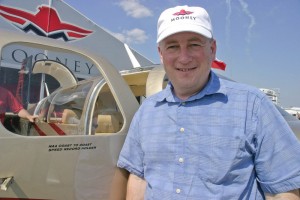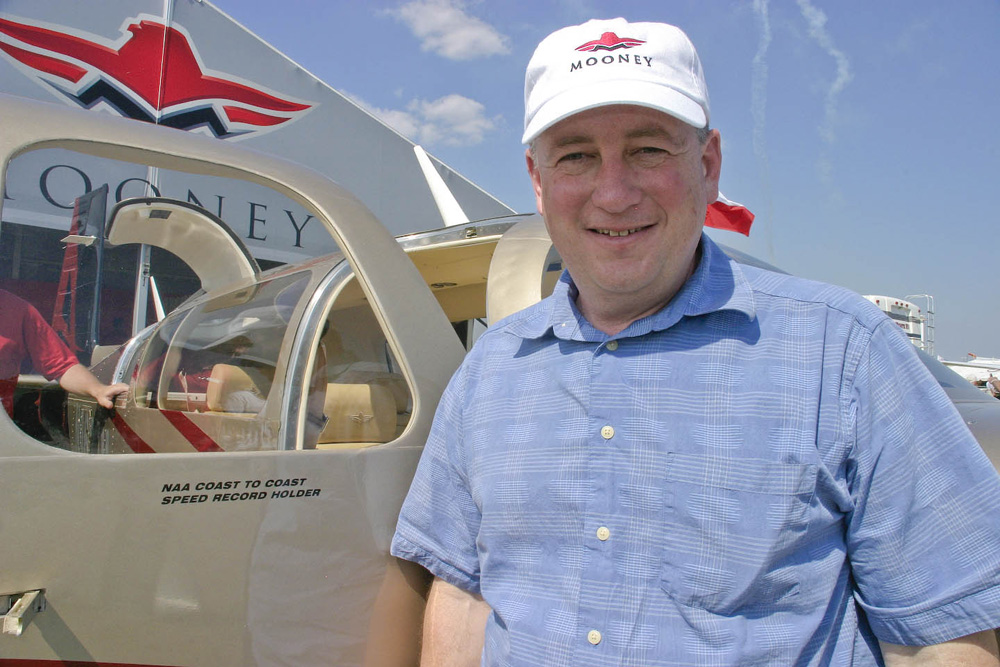
Scott Purdue piloted the Acclaim nearly 1,900 miles at a top speed of 237 ktas at FL230, helping Mooney demonstrate the power of its new aircraft.
By Jeff Mattoon
Mooney Airplane Company announced at Sun ‘n Fun 2007 that one of its aircraft has broken a speed record. It’s the new Acclaim, the latest of Mooney’s three current production models, and the model Mooney now calls its flagship.
The Acclaim sports a single TCM TSI0-550-G, twin turbo, turbo-normalized engine with dual intercoolers, touting 280 horsepower (MCP) and average cruise of 237 knots true airspeed at 25,000 feet.
With hand-stitched, reclining leather seats—front and back—and cup holders, the Acclaim looks more like a sports car than a typical, small, single-engine aircraft. On the panel, the Garmin G1000 Integrated Avionics Suite offers the latest in situational awareness and flight control.
Mooney, based in Kerrville, Texas, metaphorically refers to the new airship’s “rippling muscles,” but after considering what features adorn the cabin as well as what’s under the hood, one realizes this is a confident and friendly muscle-ripped dude, not the kick-sand-in-your-face sort.
Enter Scott Purdue, writer and pilot. Purdue had just finished a story on the new Acclaim, when Mooney representatives asked if he would like to help set a new speed record.
The flight took place on April 6, 2007, from San Diego to Charlotte, N.C., with a refueling stop outside Oklahoma City.
“We didn’t target a specific day that would have favorable weather,” Purdue said. “I would have loved to have gone in January or February, to get the best winds because of the jet stream, but that wasn’t an option. Due to my schedule and the airplane’s availability, only one day would work; that’s the day we went.”
Mooney left all the flight planning to Purdue, telling him only to “fly coast to coast and see what you can do.”
Purdue, understanding that advertised numbers from some manufacturers don’t truly reflect reality for the typical use of an airplane, set out to deliver some reality in his quest.
“We didn’t do anything special,” reflects Purdue. “I didn’t want to just go flat out as fast as the plane could go. I wanted to fly it on the typical profile of an average business flyer. My objective was to see what this plane could do in real world conditions. I didn’t remove seats or lighten the load in any way. I wanted this trip to be very representative of the way the aircraft is used.”
Purdue’s planning involved three basic elements: realistic destinations, fuel consumption and center of gravity. For CG issues, Purdue took the airplane design into account. Mooney aircraft are typically a bit nose heavy, and Purdue knew how to handle that.
“The designers wanted pilots to be able to fly trimmed out, hands-off on approach, and that creates a bit of trim drag,” he said. “To overcome that, I just loaded my bags aft. In any well-designed airplane, as pilots burn fuel, they want their CG to move aft. I was within 150 to 200 pounds of gross weight.”

On April 6, the Acclaim set a new cross-country speed record. The aircraft is the latest of Mooney’s three current production models.
Purdue also had a specific fuel strategy that might, on paper, contradict a speed record.
“I had to fly lean of peak to have enough IFR reserves in Oklahoma,” he said.
Because of overcast in Norman, Okla., Purdue had to fly an IFR approach.
“I would have liked to set rich of peak for performance, but again, I had to consider my conditions,” remembered Purdue. “With that, I was burning 17 gph and still flying 223 ktas—and that’s some pretty serious speed.”
The first leg didn’t offer favorable winds—no head winds, but certainly nothing blowing from behind. On the second leg of the trip, Purdue enjoyed a healthy tail wind. Again, he brought reality into the fuel mixture strategy. He could’ve run a relatively rich mixture for performance, but he chose to stay true to his mission.
“Engine manufacturers will tell you the best power is at 50 degrees rich of peak, but that’s the worst place to run an engine,” he said. “If you’re a race car driver and all you’re interested in is pure power, that’s great, but you can’t expect an engine to live long if you run it that way.”
He said that the race car engine needs to last only about 500 miles before a rebuild, but for an airplane, that’s less than ideal.
“As an airplane owner, I need to have a balance so the engine will last to TBO (time before overhaul), so I ran it 100 degrees rich of peak,” Purdue said. “That turned out to burn about 22.7 gph.”
As the flight neared its final destination, Purdue took pictures of the panel, which was displaying impressive data.
“At one point, coming into Charlotte, I saw 237 true at FL230,” beamed Purdue. “Mooney’s numbers are 237 true at FL250, but with max power. I saw that we could do better than advertised with this aircraft, probably another four or five knots.”
Mooney is proud of the speed record, but that’s not the goal.
“We don’t need speed records to demonstrate the Acclaim’s world-class performance,” said David Copeland, Mooney’s vice president of sales and marketing. “The results of this trip reinforce the airplane’s exceptional versatility and illustrates that it’s a viable—and economical—choice for personal travel.”
The historic flight took seven hours and 24 minutes, traversing nearly 1,900 miles. Cruise range was 225 to 237 ktas, while cruise altitudes ranged from FL230 to FL250. Details of the cross-country flight have been submitted to the National Aeronautics Association for review and certification for piston-powered aircraft in the 2,205-3,358 lb. category.
For more information about Mooney Airplane Company, visit [http://www.mooney.com].











